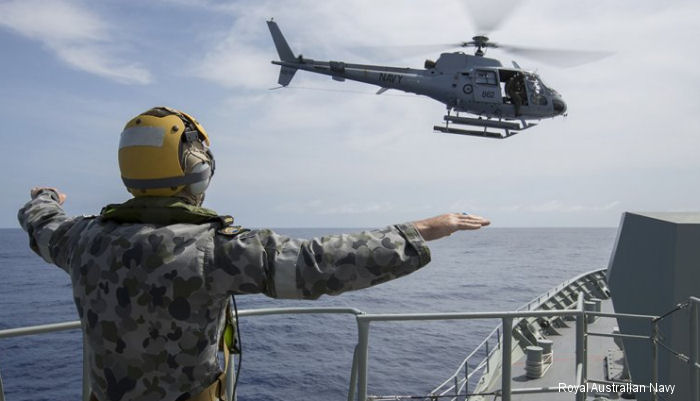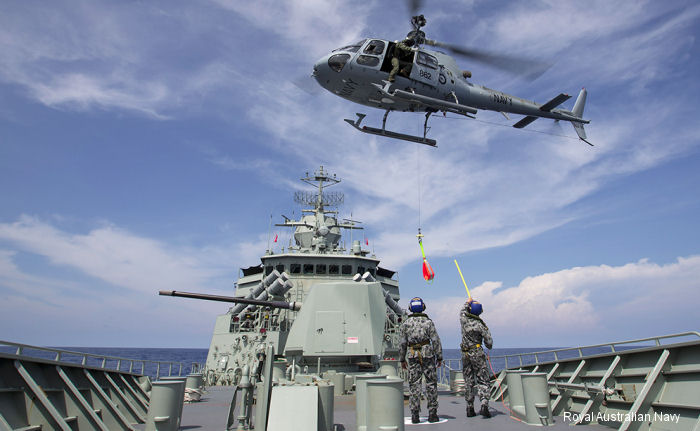Royal Australian Navy, April 12, 2015 - Indian Ocean By Lt Des Paroz - Sailing across the Indian Ocean on its way to Anzac Cove and beyond, the Royal Australian Navy helicopter frigate HMAS Anzac has kept itself busy with daily flying operations using the ship’s embarked AS350BA Squirrel helicopter.
The flying operations have been a good opportunity to consolidate the skills of the flight crew; the ship’s embarked flight team and a range of crew members who are involved in the daily flying operations.
Anzac’s Flight Commander, Lieutenant Commander Nick Plenty, is overseeing the program to ensure that the ship can maximise the value of the Squirrel – a light utility and training aircraft from 723 Squadron.
“In Anzac we have a Pilot and an Aviation Warfare Officer who are undertaking their first sea posting as part of a flight crew, along with new Helicopter Control Officers, Aircraft Controllers and Flight Deck Team members that are part of ship’s company.
“In addition, several of Anzac’s Maritime Warfare Officers are new to flying operations, and their role in ensuring the ship is within operating limits for launching and recovering a helicopter is crucial.
“The ship’s organic flying capability is made up of a variety of individuals whose flying responsibilities are ancillary duties to their core role, for example our Flight Deck Marshallers include the Physical Trainer and a Maritime Logistics – Personnel sailor, and our Helicopter Control Officers include the Maritime Logistics Officer, her deputy, and the Public Affairs Officer.
“Ensuring this diverse group of people can work together seamlessly to support flight operations requires constant training of individual and team skills,” Lieutenant Commander Plenty said.
“Throughout our deployment on NORTHERN TRIDENT 2015, the embarked flight will be used for a range of activities, including personnel and materiel transport, search and rescue, and mission support operations.”
The range of training operations undertaken has included deck landing practices, navigation sorties, and utility exercises such as vertical replenishments and passenger transfer operations over both the ship’s flight deck and forecastle.
Acting Sub Lieutenant Danielle Cole is a Maritime Warfare Officer, currently completing her phase IV training to gain her Platform Endorsement to be an Officer of the Watch in Anzac.
“As an Officer of the Watch, flying operations mean we must strike a balance between ensuring the ship is able to drive forward with its navigational or warfare duties, while ensuring that we achieve appropriate environmental conditions for flying.
“It is a complex balancing act, as a heading that is optimal for flying might not align with the ship’s intended course.
“The whole ship needs to be on the ball so that a navigational course can be resumed as soon as practical after a flying evolution.
“During training, flying operations really test our entire ship management, knowledge and skills,” Acting Sub Lieutenant Cole said.
While many of the flying evolutions occur within close proximity to the ship, some involve navigational exercises that take the aircraft well out of sight of the Anzac, something that is not lost on the ship’s Flight Operations Officer, Sub Lieutenant Pat Hitchings.
“Working out in the Indian Ocean I am keenly aware that when we fly the aircraft off the ship we simply don’t have the legs to make it back to land.
“The ship is our only option to land safely, so the first time we went ‘over the horizon’ and came back to successfully find the ship I felt a great sense of relief that my training and planning had worked.
“It was a pretty awesome feeling.
“To operate an aircraft directly involves at least a dozen people on the ship, plus the flight crew and the maintainers that look after the aircraft
“It is only through the efforts of a well trained and integrated team that we can achieve our goals and add an important capability to a Navy ship at sea,” Sub Lieutenant Hitchings said.
HMAS Anzac is currently deployed on NORTHERN TRIDENT 2015 during which it will participate in the Centenary of ANZAC commemorations in April, followed by a series of important international engagements.
The flying operations have been a good opportunity to consolidate the skills of the flight crew; the ship’s embarked flight team and a range of crew members who are involved in the daily flying operations.
Anzac’s Flight Commander, Lieutenant Commander Nick Plenty, is overseeing the program to ensure that the ship can maximise the value of the Squirrel – a light utility and training aircraft from 723 Squadron.
“In Anzac we have a Pilot and an Aviation Warfare Officer who are undertaking their first sea posting as part of a flight crew, along with new Helicopter Control Officers, Aircraft Controllers and Flight Deck Team members that are part of ship’s company.
“In addition, several of Anzac’s Maritime Warfare Officers are new to flying operations, and their role in ensuring the ship is within operating limits for launching and recovering a helicopter is crucial.
“The ship’s organic flying capability is made up of a variety of individuals whose flying responsibilities are ancillary duties to their core role, for example our Flight Deck Marshallers include the Physical Trainer and a Maritime Logistics – Personnel sailor, and our Helicopter Control Officers include the Maritime Logistics Officer, her deputy, and the Public Affairs Officer.
“Ensuring this diverse group of people can work together seamlessly to support flight operations requires constant training of individual and team skills,” Lieutenant Commander Plenty said.
“Throughout our deployment on NORTHERN TRIDENT 2015, the embarked flight will be used for a range of activities, including personnel and materiel transport, search and rescue, and mission support operations.”
The range of training operations undertaken has included deck landing practices, navigation sorties, and utility exercises such as vertical replenishments and passenger transfer operations over both the ship’s flight deck and forecastle.
Acting Sub Lieutenant Danielle Cole is a Maritime Warfare Officer, currently completing her phase IV training to gain her Platform Endorsement to be an Officer of the Watch in Anzac.
“As an Officer of the Watch, flying operations mean we must strike a balance between ensuring the ship is able to drive forward with its navigational or warfare duties, while ensuring that we achieve appropriate environmental conditions for flying.
“It is a complex balancing act, as a heading that is optimal for flying might not align with the ship’s intended course.
“The whole ship needs to be on the ball so that a navigational course can be resumed as soon as practical after a flying evolution.
“During training, flying operations really test our entire ship management, knowledge and skills,” Acting Sub Lieutenant Cole said.
While many of the flying evolutions occur within close proximity to the ship, some involve navigational exercises that take the aircraft well out of sight of the Anzac, something that is not lost on the ship’s Flight Operations Officer, Sub Lieutenant Pat Hitchings.
“Working out in the Indian Ocean I am keenly aware that when we fly the aircraft off the ship we simply don’t have the legs to make it back to land.
“The ship is our only option to land safely, so the first time we went ‘over the horizon’ and came back to successfully find the ship I felt a great sense of relief that my training and planning had worked.
“It was a pretty awesome feeling.
“To operate an aircraft directly involves at least a dozen people on the ship, plus the flight crew and the maintainers that look after the aircraft
“It is only through the efforts of a well trained and integrated team that we can achieve our goals and add an important capability to a Navy ship at sea,” Sub Lieutenant Hitchings said.
HMAS Anzac is currently deployed on NORTHERN TRIDENT 2015 during which it will participate in the Centenary of ANZAC commemorations in April, followed by a series of important international engagements.
AS350B Ecureuil N22-015 ( Fleet Air Arm (RAN) )
See also |
AS350 Ecureuil in






